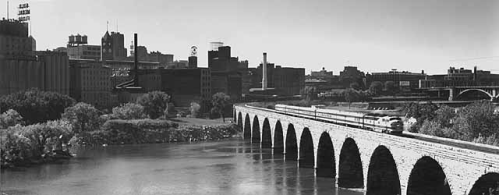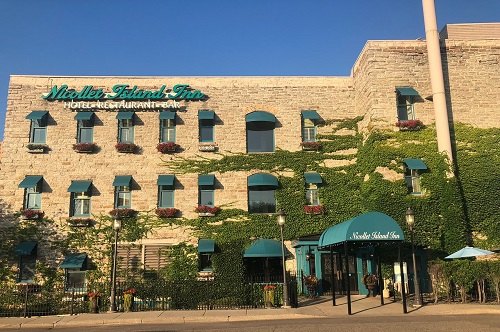Unique Partnership Provides Trained Mental Health Services Downtown – Immediately and Where Needed
 Friday, April 1, 2022 at 9:25AM |
Friday, April 1, 2022 at 9:25AM |  Becky Fillinger |
Becky Fillinger | Article by Becky Fillinger
Local citizens in dire need of mental and chemical health services are often not able to obtain support when and where needed. A unique partnership between the Downtown Improvement District (DID) and Hennepin County Behavioral Health is doing just that – help those in need find services.
 James Seals, Outreach Social Worker with Hennepin County Behavioral Health, standing in front of the Downtown Improvement District (DID) van that is used to transport residents from the Downtown District to the Behavioral Health Center at 1800 Chicago to facilitate connections to services and supports for needs related to mental health and substance use.
James Seals, Outreach Social Worker with Hennepin County Behavioral Health, standing in front of the Downtown Improvement District (DID) van that is used to transport residents from the Downtown District to the Behavioral Health Center at 1800 Chicago to facilitate connections to services and supports for needs related to mental health and substance use.
Shane Zahn, DID Director of Safety Initiatives, shared with us the history of the project.
“The DID Livability Team and outreach partners had been contemplating how to improve the service response to those they served downtown for a while, and the increased need for trained mental health outreach in downtown was very evident at the start of the pandemic,” Zahn said. “In the spring of 2020, DID added its Social Impact Manager position and welcomed Joe Kreisman to the team. This gave DID the skills to begin reaching out to a variety of community partners and nonprofits to see how we could expand outreach services and upstream resources downtown. The partnership with Hennepin County came to fruition. Downtown’s proximity to the Behavioral Health Center at 1800 Chicago and the concentration of need from the shelters and services in and around downtown made it a seamless fit.”
 Behavioral Health Center at 1800 Chicago
Behavioral Health Center at 1800 Chicago
 The entrance off of Chicago is temporarily closed, but there is an entrance off of Columbus for walk-in traffic Monday – Friday 9:00am-9:00pm (expanded hours as of 4/1/22).
The entrance off of Chicago is temporarily closed, but there is an entrance off of Columbus for walk-in traffic Monday – Friday 9:00am-9:00pm (expanded hours as of 4/1/22).
The other half of the partnership comes from Behavioral Health at Hennepin County. Kate Erickson, Manager in Behavioral Health, told us there was a need to assist residents in getting connected to longer-term services and supports.
“There is already great work going on in Downtown Minneapolis that we can build upon – DID Livability Teams, Mad Dads of Minneapolis, YouthLink MN, Violence Interrupters, etc.,” Erickson said. “This collaboration assists residents in resolving the immediate need, and getting connected to longer-term services and support for needs related to mental health and substance use. As the county, we can see what services someone might already have in place, and work with the residents to find the right services to meet their needs.”
So how does this partnership actually work? James Seals was hired as an Outreach Social Worker at Hennepin County. As a Hennepin County employee, he has access to information, resources, and additional specialized staff at the County, and specifically the Behavioral Health Center. DID was able to share the costs of the Social Worker position, with help from the Downtown Minneapolis Neighborhood Association (DMNA). In addition, DID purchased a minivan – which allows Seals to navigate the District more effectively while also providing a vehicle to transport clients to services. Both the County and DID are able to bring their unique attributes to the partnership and dramatically enhance what either could have done on their own. With the intentional work of both Zahn and Kreisman, this position has been connected to and become an integral part of the DID’s work in this area.
Social Worker James Seals is rarely stationary. We spoke as he was moving through Downtown buildings, responding to calls from citizens, property managers or building security managers. He shared that he spends most of his time doing outreach to the community Downtown, building relationships with people, and working to provide immediate and long-term needs. “As I get to know them, I can help them get connected to services right away,” Seals said. “I can provide a ride to the Behavioral Health Center and connect them to the care team there. The team can determine what services the resident needs. I work the 120+ city blocks of downtown Minneapolis, meeting residents in need of support and making those connections."
"Some interventions don’t happen immediately. I connected with a resident who was struggling with ongoing substance use and experiencing homelessness. When I first met the resident, he was frequently seen on street corners in downtown Minneapolis signing and sleeping in bus shelters. Over the course of three months, I engaged with the resident, daily at times, to build rapport, assess needs, and assist with connection to services. The resident is now housed, connected to an integrated primary care clinic, and is connected to a case manager through the Diversion and Recovery Team (DART) who support him with his recovery and quality of life improvement goals. That looks like success to me.” DART sees residents in the Behavioral Health Center, the community and their home, providing long-term case management for those living with a substance use disorder and experiencing housing instability.
Elizabeth Bieging, Supervisor in Behavioral Health at Hennepin County, elaborates on the care available. “At the Behavioral Health Center, we have walk-in services on the 1st floor, a crisis residence on the 2nd floor, and withdrawal management on the 3rd floor. We have recovery programs on site, such as long-term case managers who serve people living with a substance use disorder, vocational support for those who need help getting or keeping a job (but mental health or substance use is getting in the way), and health insurance navigation to ensure people have health insurance coverage to access needed services.” Learn more at www.hennepin.us/1800-Chicago.
Is the program successful? Kreisman said yes.
“The ability to connect community members downtown with their existing resources and support systems has been invaluable already.” Kreisman said. “The Social Worker has been able to get folks into mental health resources, substance use disorder treatment, withdrawal management, shelter, and de-escalate situations downtown to reduce 911 calls for police and medical response.”
Bieging agrees.
“The outcomes we are working towards are reducing any unnecessary emergency room use or inpatient hospitalization, reducing any unnecessary criminal justice system involvement, and facilitating connections to services and supports for Hennepin County residents 18+, centering needs related to mental health and substance use,” Bieging said. “We are having success! In only a year since we launched this effort, the Social Worker has already been able to connect residents to treatment facilities, mental health resources, and housing, and it is such a joy to all of us to know they are finding stability and care on the terms they wanted.”
Erickson shared quantitative results as well. James Seals, the Social Worker, made a total of 357 contacts with 153 residents between September and December, 2021 on the 120+ city blocks of downtown Minneapolis. Fifty percent of those contacts identified needs related to substance use disorder and 29% identified needs related to mental health. In the same time period, James provided transportation to 26 residents to facilitate connections to treatment and recovery support at the Behavioral Health Center at 1800 Chicago. In addition, all community members were provided individualized information and resources to use when they were ready.
Will the program be expanded? Zahn told me, “DID assessment resources are limited to the 120 square blocks of the City, but we know that downtown is much broader than our District as everyone seamlessly moves in and out of the boundaries. However, DID’s core services do not go beyond the boundaries of the District. This model of having a vehicle for effective transportation, the Outreach Social Worker as a County employee, and additional funding sources has allowed us to leverage the infrastructure the DID has developed in this work to reach residents who are in and out of the DID boundary. Residential neighborhoods that are currently being served but are outside the District’s boundaries include the Mill District, Philips, North Loop and Loring Park.” When the resident is ready to connect to services, Seals provides transportation to the Behavioral Health Center at 1800 Chicago.
Walk-in services are available for Hennepin County residents 18+, centering needs related to mental health and substance use, open Monday-Friday 9:00am-9:00pm at the Behavioral Health Center at 1800 Chicago. The team assists residents in connecting to on-site and community-based services.
Learn more about these resources:
- Behavioral Health Center and Video Walk-in behavioral health support referrals - social workers - YouTube
- Diversion and Recovery Team (DART)
- Downtown Safety Collaborative (mplsdid.com)
Other county-based resources related to this article include:
- Mental Health Emergencies Mental health emergencies | Hennepin County
- Emergency Services Emergency programs | Hennepin County
- Hennepin County Front Door, 612-348-4111





















































